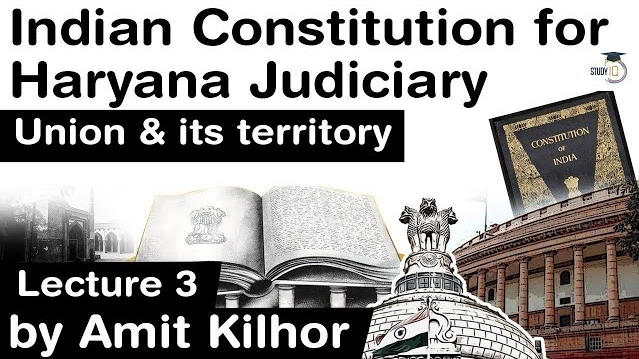Table of Contents
- The Constitution of India is the supreme law of India. The document lays down the framework that demarcates fundamental political code, structure, procedures, powers, and duties of government institutions and sets out fundamental rights, directive principles, and the duties of citizens. It is the longest written constitution of any country on earth.
- It imparts constitutional supremacy (not parliamentary supremacy, since it was created by a constituent assembly rather than Parliament) and was adopted by its people with a declaration in its preamble. Parliament cannot override the constitution.
- It was adopted by the Constituent Assembly of India on 26 November 1949 and became effective on 26 January 1950.The constitution replaced the Government of India Act 1935 as the country’s fundamental governing document, and the Dominion of India became the Republic of India.
- The Indian constitution is the world’s longest for a sovereign nation. At its enactment, it had 395 articles in 22 parts and 8 schedules. At about 145,000 words, it is the second-longest active constitution—after the Constitution of Alabama—in the world.
- The constitution has a preamble and 470 articles, which are grouped into 25 parts. With 12 schedules and five appendices, it has been amended 104 times; the latest amendment became effective on 25 January 2020.
- Preamble,[43] with the words “socialist”, “secular” and ‘integrity’ added in 1976 by the 42nd amendment
- Part I – States and union territories
- Part II – Citizenship
- Part III – Fundamental Rights
- Part IV – Directive Principles of State Policy
- Part IVA – Fundamental Duties
- Part V – The union
- Part VI – The states
- Part VII – States in the B part of the first schedule (repealed)
- Part VIII– Union territories
- Part IX – Panchayats
- Part IXA – Municipalities
- Part IXB – Co-operative societies
- Part X – Scheduled and tribal areas
- Part XI – Relations between the union and the states
- Part XII – Finance, property, contracts and suits
- Part XIII – Trade and commerce within India
- Part XIV – Services under the union and states
- Part XIVA – Tribunals
- Part XV – Elections
- Part XVI – Special provisions relating to certain classes
- Part XVII – Languages
- Part XVIII – Emergency provisions
- Part XIX – Miscellaneous
- Part XX – Amending the constitution
- Part XXI – Temporary, transitional and special provisions
- Part XXII – Short title, date of commencement, authoritative text in Hindi and repeals

Appendices
- Appendix I– The Constitution (Application to Jammu and Kashmir) Order, 1954
- Appendix II– Re-statement, referring to the constitution’s present text, of exceptions and modifications applicable to the state of Jammu and Kashmir
- Appendix III– Extracts from the Constitution (Forty-fourth Amendment) Act, 1978
- Appendix IV– The Constitution (Eighty-sixth Amendment) Act, 2002
- Appendix V– The Constitution (Eighty-eighth Amendment) Act, 2003

Union and its Territory
- Articles 1 to 4 under Part-I of the Constitution deal with the Union and its territory
- Article 1 describes India, that is, Bharat as a ‘Union of States’ rather than a ‘Federation of States’. This provision deals with two things: one, name of the country; and two, type of polity.
- According to Article 1, the territory of India can be classified into three categories:
- Territories of the states
- Union territories
- Territories that may be acquired by the Government of India at any time.

- Article 2 empowers the Parliament to ‘admit into the Union of India, or establish, new states on such terms and conditions as it thinks fit’.
- Thus, Article 2 grants two powers to the Parliament:
- (a) the power to admit into the Union of India new states; and
- (b) the power to establish new states. The first refers to the admission of states which are already in existence, while the second refers to the establishment of states which were not in existence before.
- Notably, Article 2 relates to the admission or establishment of new states that are not part of the Union of India.

Article 3 authorises the Parliament to:
- (a) form a new state by separation of territory from any state or by uniting two or more states or parts of states or by uniting any territory to a part of any state;
- (b) increase the area of any state;
- (c) diminish the area of any state;
- (d) alter the boundaries of any state; and
- (e) alter the name of any state.
- Article 3, on the other hand, relates to the formation of or changes in the existing states of the Union of India. In other words,
- Article 3 deals with the internal re-adjustment inter se of the territories of the constituent states of the Union of India.
- Parliament can redraw the political map of India according to its will. Hence, the territorial integrity or continued existence of any state is not guaranteed by the Constitution. Therefore, India is rightly described as ‘an indestructible union of destructible states’.
- the Constitution (Article 4) itself declares that laws made for admission or establishment of new states (under Article 2) and formation of new states and alteration of areas, boundaries or names of existing states (under Articles 3) are not to be considered as amendments of the Constitution under Article 368. This means that such laws can be passed by a simple majority and by the ordinary legislative process.
- The decision of the Central Government to cede part of a territory known as Berubari Union (West Bengal) to Pakistan??
- Does the power of Parliament to diminish the areas of a state (under Article 3) include also the power to cede Indian territory to a foreign country?




Haryana Judiciary Exams 2021 | Free PDF Download






















 WhatsApp
WhatsApp